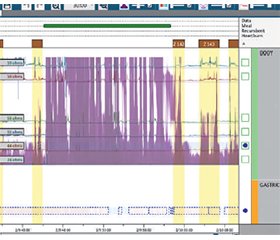Журнал "Гастроэнтерология" Том 59, №2, 2025
Вернуться к номеру
Внутрішньостравохідна імпеданс-рН-манометрія: загальні положення, клінічне значення, розбір клінічного випадку
Авторы: Степанов Ю.М. (1), Будзак І.Я. (2)
(1) - ДУ «Інститут гастроентерології НАМН України», м. Дніпро, Україна
(2) - Дніпровський державний медичний університет, м. Дніпро, Україна
Рубрики: Гастроэнтерология
Разделы: Справочник специалиста
Версия для печати
У статті висвітлено інноваційний метод діагностики гастроезофагеальної рефлюксної хвороби — імпеданс-рН-моніторинг. Розкрита сутність методу, показана апаратура для його проведення, подані правила підготовки пацієнта до дослідження. Детально проаналізовані параметри оцінки результатів. Наведені показання до проведення імпеданс-рН-моніторингу в діагностиці гастроезофагеальної рефлюксної хвороби згідно з Ліонським консенсусом 2.0. Окремо детально проаналізований клінічний випадок застосування імпеданс-рН-моніторингу в пацієнта з підозрою на гастроезофагеальну рефлюксну хворобу. Подані численні графічні ілюстрації результатів імпеданс-рН-моніторингу, оцінені цифрові показники моніторингу.
The article describes an innovative method for diagnosing gastroesophageal reflux disease — impedance-pH monitoring. The essence of the method, the equipment for its implementation, and the rules for preparing the patient for the examination are shown. The parameters for evaluating the results are analyzed in detail. The indications for its implementation in the diagnosis of gastroesophageal reflux disease according to the Lyon Consensus 2.0 are given. A clinical case of the use of impedance-pH monitoring in a patient with suspected gastroesophageal reflux disease is analyzed in detail. Numerous graphic illustrations of the results of impedance-pH monitoring are shown, and digital monitoring indicators are evaluated.
гастроезофагеальна рефлюксна хвороба; діагностика; імпеданс-рН-моніторинг
gastroesophageal reflux disease; diagnosis; impedance-pH monitoring
Для ознакомления с полным содержанием статьи необходимо оформить подписку на журнал.
- Baron JH. One-hundred-and-fifty years of measurements of hydrochloric acid in gastric juice. Br Med J. 1973 Dec 8;4(5892):600-1. doi: 10.1136/bmj.4.5892.600.
- Sharma N, Agrawal A, Freeman J, Vela MF, Castell D. An analysis of persistent symptoms in acid-suppressed patients undergoing impedance-pH monitoring. Clin Gastroenterol Hepatol. 2008 May;6(5):521-4. doi: 10.1016/j.cgh.2008.01.006.
- Rasouli A, Soheilipour M, Raisi M, Rabbani H, Eghbalifard N, Adibi P. Reflux definitions in esophageal multi-channel intraluminal impedance. Gastroenterol Hepatol Bed Bench. 2023;16(4):408-414. doi: 10.22037/ghfbb.v16i4.2776.
- Krause A, Yadlapati R. Reflux Testing: Wireless pH, Impe–dance-pH, and Mucosal Impedance. Gastrointest Endosc Clin N Am. 2025;35(3):587-601.
- Shay S, Tutuian R, Sifrim D, Vela M, Wise J, Balaji N, et al. Twenty-four hour ambulatory simultaneous impedance and pH moni–toring: a multicenter report of normal values from 60 healthy volunteers. Am J Gastroenterol. 2004 Jun;99(6):1037-43. https://doi.org/10.1111/j.1572-0241.2004.04172.x.
- Ravi K, DeVault KR, Murray JA, Bouras EP, Francis DL. Inter-observer agreement for multichannel intraluminal impedance-pH testing. Dis Esophagus. 2010;23(7):540-544. doi: 10.1111/j.1442-2050.2010.01060.x.
- Gyawali CP, Kahrilas PJ, Savarino E, et al. Modern diagnosis of GERD: the Lyon Consensus. Gut. 2018;67(7):1351-1362. doi: 10.1136/gutjnl-2017-314722.
- Sonoda M, Matsumura T, Dao HV, et al. A prediction model of abnormal acid reflux in gastroesophageal reflux disease. J Gastroenterol Hepatol. 2024;39(9):1847-1855.
- Olmos JA, Pandolfino JE, Piskorz MM, et al. Latin American consensus on diagnosis of gastroesophageal reflux disease. Neurogastroenterol Motil. 2024;36(3):e14735. doi: 10.1111/jgh.16602.
- Zhang L, Zhang M, Chen Q, et al. Improved diagnostic yield of symptom association probability involving only cough for gastroesophageal reflux-induced chronic cough. J Thorac Dis. 2023;15(4):2277-2287.
- Wu Y, Guo Z, Zhang C, Zhan Y. Role of the Mean Nocturnal Baseline Impedance in Identifying Evidence Against Pathologic Reflux in Patients With Refractory Gastroesophageal Reflux Disease Symptoms as Classified by the Lyon Consensus. J Neurogastroenterol Motil. 2022 Jan 30;28(1):121-130. doi: 10.5056/jnm20277.
- Frazzoni M, de Bortoli N, Frazzoni L, et al. The added diagnostic value of postreflux swallow-induced peristaltic wave index and nocturnal baseline impedance in refractory reflux disease studied with on-therapy impedance-pH monitoring. Neurogastroenterol Motil. 2017;29(3):10. doi: 10.1111/nmo.12947.
- Sun YM, Gao Y, Gao F. Role of Esophageal Mean Nocturnal Baseline Impedance and Post-reflux Swallow-induced Peristaltic Wave Index in Discriminating Chinese Patients With Heartburn. J Neurogastroenterol Motil. 2019;25(4):515-520. doi: 10.5056/jnm19056.
- Frazzoni M, Savarino E, de Bortoli N, et al. Analyses of the Post-reflux Swallow-induced Peristaltic Wave Index and Nocturnal Baseline Impedance Parameters Increase the Diagnostic Yield of Impedance-pH Monitoring of Patients With Reflux Disease. Clin Gastroenterol Hepatol. 2016;14(1):40-46. doi: 10.1016/j.cgh.2015.06.026.
- Lombo-Moreno C, La Rotta D, Pardo-Ortiz M, et al. Diagnostic accuracy of mean nocturnal basal impedance and other complementary tests for the diagnosis of gastroesophageal reflux disease according to the new Lyon criteria. Therap Adv Gastroenterol. 2025;18:17562848251340495. Published 2025 May 22. doi: 10.1177/17562848251340495. eCollection 2025.
- Patel A, Wang D, Sainani N, Sayuk GS, Gyawali CP. Distal mean nocturnal baseline impedance on pH-impedance monitoring predicts reflux burden and symptomatic outcome in gastro-oesophageal reflux disease. Aliment Pharmacol Ther. 2016;44(8):890-898. doi: 10.1111/apt.13777.
- Świdnicka-Siergiejko AK, Marek T, Waśko-Czopnik D, et al. Diagnostic and therapeutic management in gastroesophageal reflux disease: consensus of the Polish Society of Gastroenterology. Pol Arch Intern Med. 2022;132(2):16196. doi: 10.20452/pamw.16196.
- Gyawali CP, Yadlapati R, Fass R Updates to the modern diagnosis of GERD: Lyon consensus 2.0. Gut. 2024 Jan 5;73(2):361-371.
- Pritchett JM, Aslam M, Slaughter JC, Ness RM, Garrett CG, Vaezi MF. Efficacy of esophageal impedance/pH monitoring in patients with refractory gastroesophageal reflux disease, on and off therapy. Clin Gastroenterol Hepatol. 2009 Jul;7(7):743-8. doi: 10.1016/j.cgh.2009.02.022.
- Hirano I, Richter JE; Practice Parameters Committee of the American College of Gastroenterology. ACG practice guidelines: esopha–geal reflux testing. Am J Gastroenterol. 2007 Mar;102(3):668-85. doi: 10.1111/j.1572-0241.2006.00936.x.

